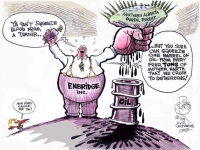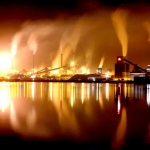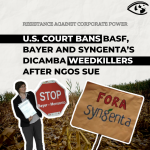The Enbridge Oil Sands Gamble

Patrick Daniel, the CEO of Enbridge Inc, is bullish about the future of unconventional oil from Canada's massive tar sand deposits. And understandably so. His successful company not only operates North America's longest crude oil and liquid pipelines, but transports 12 percent of the oil that the United States imports daily from Canada.
"Energy is necessary for us to live long healthy lives," he told a business audience this past September during remarks to the Edmonton Chamber of Commerce. "The oil sands is the second largest reserve in the world, and we can't deny access to the rest of the world to that huge resource." [1]
Canada's highly unconventional resource (heavy oil from sand or rock) lies under a forest area the size of England (140,000 square kilometers) and is arguably the world's last remaining giant oil field. Almost every major private and state-owned oil company has a presence in the tar sands. The project could make Canada the world's fifth largest oil exporter by 2020.
But Daniel's boosterism for unconventional oil is not shared by the band council of Hartley Bay, near the northern deep-water port of Kitimat, British Columbia (BC). When he showed up in September, community members of the Gitga'at people sat across from the proposed marine terminal for Enbridge's $5 billion Northern Gateway pipeline.
The 1,170 kilometer-long dual pipeline would daily transport 525,000 barrels of bitumen, from Edmonton, Alberta, across two provinces and over mountains in some of the world's most rugged terrain to Kitimat. From there, ocean tankers would take the inferior asphalt-like hydrocarbon to Asian refineries for processing into transportation fuels.
A parallel and smaller pipeline would move highly toxic condensate (a petroleum by-product used to thin heavy oil) imported from Russian and Indonesian markets to Alberta's tar sands. Bitumen, a thick gooey resource with low gravity, simply can't move through a pipeline unless diluted with up to 50 percent condensate. (For company information on the project, consult: http://www.northerngateway.ca/)
The project will traverse lands claimed or occupied by 40 aboriginal groups. The Gitga'at people, who have lived long and healthy lives by the Pacific Ocean for thousands of years without consuming much condensate or oil, told Daniel that his grand scheme threatened their traditional way of life as well as their food supply, including salmon, mussels and sea kelp.
"You are welcome in our territory as individuals, but your project is not," declared Hereditary Chief Ernie Hill Jr. Other salmon-dependent people along the pipeline or tanker route - including the Haida and the Haisla - gave Enbridge similar blunt messages. The tar sands, said Haida Nation leader Guujaaw, "is one of the biggest unnatural disasters going on in the world right now."
The stage is set for an epic battle between Asian and Canadian backers of North America's most powerful oil carrier and an assortment of aboriginal and environmental groups in Canada's greenest province, British Columbia. The unfolding petroleum drama, which will expose Asian refiners to extreme capital and carbon risks, could ultimately determine the pace and scale of the world's largest energy development. The Northern Gateway pipeline also raises a moral question: Is it in Canada's best interest to put more cars on the road in Shanghai at the expense of the world's most valuable salmon-spawning watersheds and the security of the globe's climate?
Global Reach
By any measure the tar sands project is a formidable energy power play. The world's major petroleum companies including the U.S.'s Exxon, Norway's Statoil and France's Total have poured more than $100 billion into developing the project over the last decade, and it now produces 1.3 million barrels a day.
But bitumen, which is more than 50 per cent pitch, is not a secure replacement for sweet crude. For starters, the asphalt-like sludge remains the world's most expensive hydrocarbon ($60 to $85 per barrel) because of the enormous amount of energy and water needed to extract it from the ground. Upgrading bitumen into synthetic crude, a process that removes carbon and adds hydrogen molecules, also requires more energy in the form of natural gas. But even the upgraded product remains so highly contaminated with sulfur, salt, acids and heavy metals that it needs additional, complex refining.
Not surprisingly, then, low quality bitumen from the tar sands has increased the energy and greenhouse gas output of U.S. refineries by 47 percent. [2] According to Canada's National Center for Upgrading Technology, bitumen simply proves the industry maxim that "as crude prices increase, crude quality decreases." [3] Although many Chinese refineries can process heavy crude such as bitumen, only five of Japan's 50 refineries can currently handle the dirty hydrocarbon without fouling their facilities.
But Asia's interest in Canadian bitumen is long standing owing to the region's near total dependence on Middle Eastern crude. Japan now imports 90 percent of its oil, while China has increasingly exhausted its domestic oil resources to fuel its industrial revolution. Its oil imports rose from 1 percent in 1993 to nearly 50 percent today. The U.S. Department of Energy estimates that by 2025, some 70 percent of China's expected 14.2 million barrels daily consumption will come from oil fields in Africa, South America or Canada.
Not surprisingly, state-owned PetroChina heavily supported Enbridge's first attempt to steer the Gateway project through Canada's regulatory regime. But Asia's largest oil company withdrew in 2007 after confronting Canadian political indifference and open U.S. hostility to the pipeline. (Some of that hostility directly relates to PetroChina's unsuccessful 2005 attempt to buy out Unocal, a U.S. oil company with critical reserves in Asia.)
Last year Enbridge revived the Gateway scheme by securing $100 million in funding from 10 anonymous tar sand producers and Asian shippers (PetroChina is probably among them). A year later PetroChina paid $1.9 billion for a majority share of two tar sand properties. The state owned Korean National Oil Co. also gobbled up $1.8 billion in assets.
But bitumen investment comes with high carbon risks. The Chinese company purchased deep deposits of bitumen that can only be extracted in situ by steam plants (oil sands must be either mined or recovered in situ), perhaps the most greenhouse gas intensive industry in global oil production. (See Sidebar.)
China and the New Oil Order
A leading champion of Chinese investment in the tar sands is Paul Michael Wihbey, director of the Washington, D.C.-based energy consulting group (GWEST, or Global Water & Energy Strategy Team http://www.gwest.net/), and a former vice president of Canada's Liberal Party. Given that China and Canada rank as the largest trading partners with the United States (and that the three countries consume 35 percent of the world's oil), Wihbey argues that "the nexus of China's energy relationship with North America is the development of unconventional heavy oils." Wihbey calls it "the new oil order" and believes that only the globalization of bitumen can keep the Chinese and U.S. economies afloat. [4]
A Primitive and Flawed Technology Critics charge that steam plant technology is primitive and riddled with problems. It burns natural gas to heat water to create steam to melt deep bitumen deposits. Greenhouse gas emissions can range between 71 to 276 kilograms per barrel of bitumen. [13] In contrast CO2 emissions from North Sea light oil range from 8 to 10 kilograms. [14] The U.S. National Energy Technology Laboratory calculated in 2009 that the Canadian bitumen used to make diesel fuel had a carbon footprint 244 percent greater than that of U.S. domestic crude. [15] The energy intensity of steam-based bitumen production has been the subject of much criticism. According to Petroleum Technology Alliance Canada (PTAC), an industry non-profit group, it takes one barrel of oil to produce four with the steam plants. But according to Charles Hall, a researcher at the State University of New York and one of the world's leading experts on the energy created by energy investments, Middle East oil burns one barrel to produce 20 more. Hall calculates that modern oil-based civilization basically needs a return of one to three to function. But developers with a stake in extending the financial life of fossil fuels ignore the reality that steam plant production of bitumen offers barely enough surplus energy to "support continued economic activity and social function." |
Wihbey even helped organize a 2009 gathering in Geneva, where Beijing expressed keen interest in establishing an energy corridor with Canada that would create a new Asian market for bitumen. "A larger commitment must be made to fully utilize our mutual strength," said a government spokesman. [5]
Canadians such as Enbridge's Daniel are only too anxious to make that corridor happen. The United States currently remains the only and largest market for Canada's dirty oil. Enbridge, the number-one shipper of bitumen and synthetic crude from the tar sands, has already overbuilt capacity to U.S. markets in the Midwest. [6]
Moreover, the U.S. government has started to review its growing dependence on Canada's dirty oil. Growing interest in low-carbon fuel standards, a new climate change program, and a push by some members of the U.S. military to reduce domestic oil consumption have made Canadian tar sand producers uneasy. A Chinese market would provide "an additional export outlet," noted Hong Kong billionaire Li Ka Shing in Oilweek Magazine. "Then you won't be subject to the U.S. as the one buyer." [7]
But market diversification for bitumen would impose a high ecological price, and impact the northern British Columbia salmon-dependent communities particularly hard. The Northern Gateway pipeline will cross the 785 rivers and streams [8] that form the world's most productive salmon habitat. Pipeline construction and operation will increase risks from pollution, oil spills and avalanches. And Enbridge's record safety record is by no means stellar. When its 6,000 barrel spill threatened the Mississippi River in 2002, the company lit the oil ablaze, creating a smoke plume one mile high and five miles long. [9] In 2006 the company reported 67 spills totaling nearly 6,000 barrels, and the next year more than doubled the amount of oil released into the environment.
Respect for laws and landscapes is another issue. After building a bitumen pipeline across Wisconsin in 2008, the company paid the state $1 million in fines for 545 violations of its water and wetland laws. [10]
The Trans Alaska Example
The fate of BC's wild and majestic coastline is what most worries northerners and aboriginals. The pipeline would not only accelerate bitumen production in Alberta, but bring as many as 300 supertankers a year to the port of Kitimat. Navigating the Douglas Channel, a narrow fjord, is no easy task. In the last two years, residents have witnessed two major boating incidents including the sinking of a ferry. According to Environment Canada, increased tanker traffic would also expose BC coastal waters to average spills of 1,000 barrels every four years and 10,000 barrels every nine years.
"It's not a matter of if, but of when an oil spill happens," says Cam Hill, a teacher and council member in Hartley Bay. "It would be catastrophic to our people and our way of life." It would also disrupt marine life, including many whale species and dolphins, seals, and porpoises.
Opponents argue that the Gateway Project poses many of the same risks to northern British Columbia that the Trans Alaska Project (TAP) brought to rural Alaska: ecological and cultural disruption, persistent leaks, and massive spills - the worst of which was the 1989 Exxon Valdez disaster that released 240,000 barrels of pipeline oil when the tanker foundered. That spill dramatically altered the lives of 39,000 people living in coastal communities, and left residue that "is nearly as toxic [today] as it was the first few weeks after the spill," [11] according to a 2009 report.
But although the risks from TAP and the Northen Gateway pipeline are similar, the benefits are not: Because bitumen carried by Enbridge's pipeline is neither refined nor produced in British Columbia, it will produce little or no royalty income for the region. It is simply a hydrocarbon freeway, and the money, like the oil, will flow elsewhere.
Enbridge advocates counter that rather than replicating TAP's failures, their project will resemble Norway's Mongstand facility in Fensfjord where 250 oil tankers do business every year. "One only has to look at Norway's national trust fund, their standard of living, health care, the simple transformation from basically a subsistence economy to one of the richest in the world to realize the potential derived from the fossil fuel industry," noted one Gateway supporter in a September letter to the Kitimat Northern Sentinel. The writer omitted that Canada, unlike Norway, has no sovereign oil fund. In contrast to Norway, which charges some of the world's highest royalties and taxes on oil, Canada and Alberta charge among the lowest. In other words, few benefits would accrue to the rural residents other than a boom and bust economy created by 4,000 temporary construction jobs.
The capital risks are also significant. A 2009 Deutsche Bank study on peak oil concluded that carbon pricing and disruptive technologies such as the electric car could ease demand for petroleum products by 2015, the same year Enbridge hopes to bring its bitumen pipeline on stream. The bank study adds that, "We believe refining is a twilight business that will struggle in a world of ever declining gasoline demand." Moreover strategic Chinese investments in natural gas and renewables could dramatically reduce that country's "oil intensity of GDP growth." [12]
"Canadian heavy oil sands" and other carbon intensive resources are unsafe investments, the report concludes, since the world, "will not grow the oil market."
When the Northern Gateway project begins public regulatory hearings with Canada's National Energy Board next year, the debate will include global carbon policies, sustained oil price volatility, electric cars, and the impact of building two pipelines across a fragile landscape claimed by aboriginal communities only to put more cars on roads in Asia.
(Andrew Nikiforuk is an energy and environmental writer based in Calgary, Alberta. His book, Tar Sands: Dirty Oil and the Future of a Continent, won the 2009 Rachel Carson Environmental Book Award.)
ENDNOTES:
[1] Patrick Daniels, Energy, Environment and the Economy, Remarks to the Edmonton Chamber of Commerce, September 23, 2009.
[2] Greg Karras, Refinery GHG Emissions From Dirty Crude, Communities for a Better Environment, April 20, 2009. Available at: http://www.cbecal.org.
[3] National Centre for Upgrading Technology, Oilsands Bitumen Processability Project, March 2006.
[4] Paul Michael Wihbey, Towards a New Oil Market Order: Heavy and Unconventional, World Heavy Oil Conference, Beijing, China, November 13, 2006.
[5] Claudia Cattaneo, "China's Oil Giant Seeks Alliance with Canada, Financial Post, June 1, 2009.
[6] Sonja Franklin, Enbridge CEO Sees Pipeline Overcapacity to US, Bloomberg, October 7, 2009.
[7] Andrea W Lorenz, Opening the Door: Pipelines are Lining up Again to Satisfy Asian Thirst for Canadian Crude Oil, Oilweek Magazine, October 1, 2008.
[8] David A Levy, Pipelines and Salmon in Northern British Columbia, Pembina Institute, October 2009.
[9] US National Transportation Safety Board, Rupture of Enbridge Pipeline and Release of Crude Oil near Cohasset, Minnesota, July 4, 2002, Pipeline Accident Report, NTSB/PAR, 2004.
[10] Wisconsin Department of Justice, Enbridge Energy Settles State Lawsuit Over Environmental Violations for $1,100,000, January 2, 2009.
[11] Exxon Valdez Oil Spill Trustee Council, Legacy of An Oil Spill: 20 Years After the Exxon Valdez, 2009.
[12] Deutsche Bank, The Peak Oil Market: Price Dynamics At the End of the Oil Age, October 4, 2009.
[13] John Nenniger, N-Solve: The Profits of Energy Efficiency vs. the High Costs of Carbon Capture, presentation to PTAC Towards Clean Energy Production Forum, Calgary, Alberta, October 2008.
[14] Statoilhydro, 2008 Offshore Environmental Statement, March 23, 2009, p. 6.
[15] National Energy Technology Laboratory (NETL), An Evaluation of the Extraction, Transport and Refining of Imported Crude Oils and the Impact of Life Cycle Greenhouse Gas Emissions, DOE/NETL-2009/1362, March 27, 2009.
[16] Charles A.S. Hall et al, What is the Minimum EROI that a Sustainable Society Must Have? Energies, January, 2009.
- 104 Globalization
- 116 Human Rights
- 182 Health
- 183 Environment
- 190 Natural Resources



